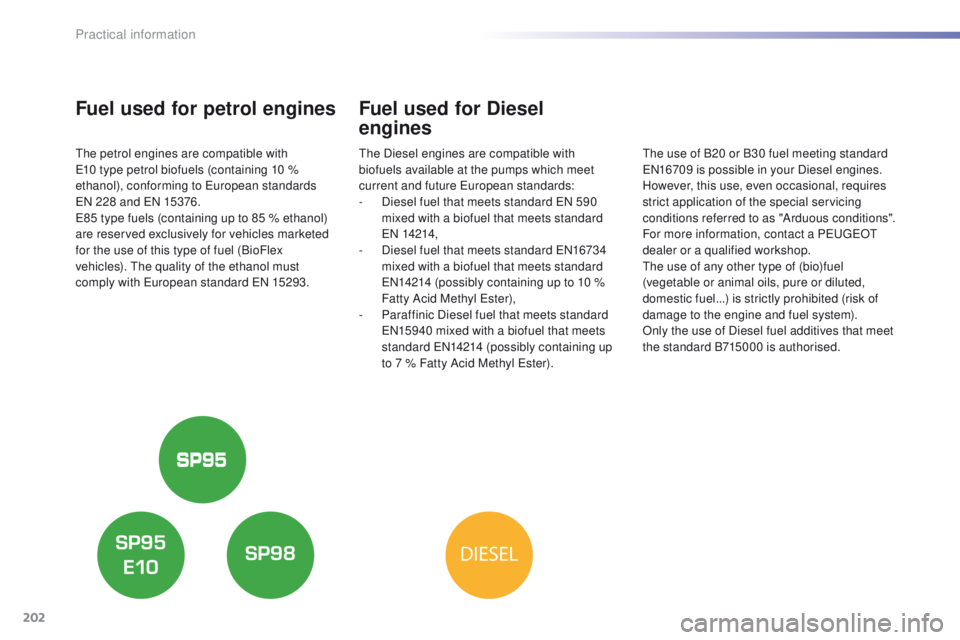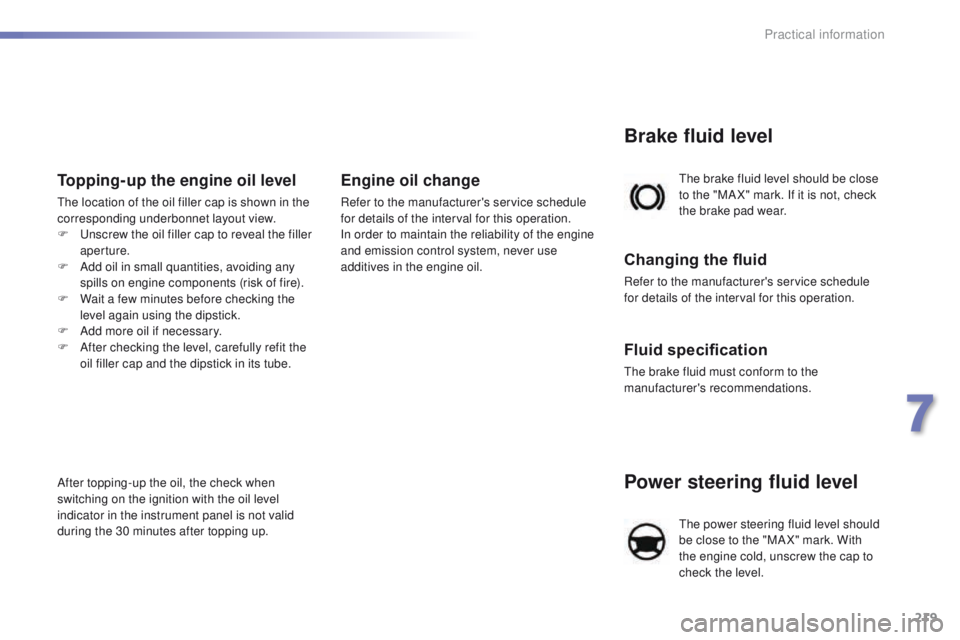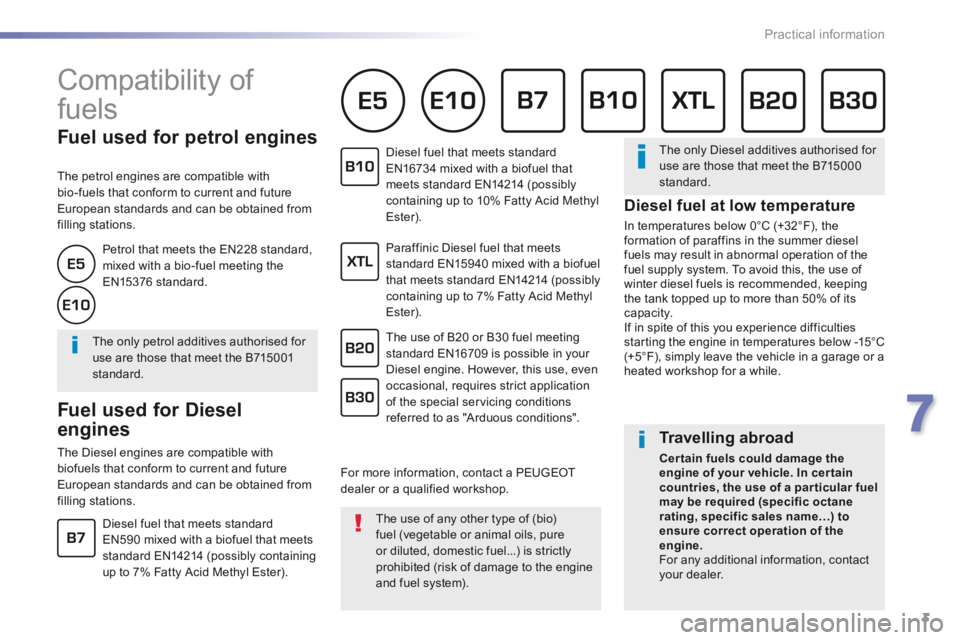oil additives Peugeot 508 2016 Owner's Manual
[x] Cancel search | Manufacturer: PEUGEOT, Model Year: 2016, Model line: 508, Model: Peugeot 508 2016Pages: 371, PDF Size: 12.12 MB
Page 204 of 371

202
DIESEL
508_en_Chap07_info-pratiques_ed01-2016
Fuel used for petrol engines
the petrol engines are compatible with e10 type petrol biofuels (containing 10 %
ethanol), conforming to
e
u
ropean standards
eN 2
28 and e
N 1
5376.
e8
5 type fuels (containing up to 85 % ethanol)
are reserved exclusively for vehicles marketed
for the use of this type of fuel (BioFlex
vehicles).
t
h
e quality of the ethanol must
comply with
e
u
ropean standard e
N 1
5293.
Fuel used for Diesel
engines
the Diesel engines are compatible with
biofuels available at the pumps which meet
current and future e
ur
opean standards:
-
D
iesel fuel that meets standard e
N 5
90
mixed with a biofuel that meets standard
eN
14214,
-
D
iesel fuel that meets standard e
N
16734
mixed with a biofuel that meets standard
eN
14214 (possibly containing up to 10 %
Fatty Acid Methyl
e
s
ter),
-
P
araffinic Diesel fuel that meets standard
eN
15940 mixed with a biofuel that meets
standard
e
N
14214 (possibly containing up
to 7 % Fatty Acid Methyl
e
s
ter).th e use of B20 or B30 fuel meeting standard eN
16709 is possible in your Diesel engines.
However, this use, even occasional, requires
strict application of the special servicing
conditions referred to as "Arduous conditions".
For more information, contact a P
e
uge
Ot
dealer or a qualified workshop.
th
e use of any other type of (bio)fuel
(vegetable or animal oils, pure or diluted,
domestic fuel...) is strictly prohibited (risk of
damage to the engine and fuel system).
Only the use of Diesel fuel additives that meet
the standard B715000 is authorised.
Practical information
Page 221 of 371

219
508_en_Chap07_info-pratiques_ed01-2016
Power steering fluid level
the power steering fluid level should
be close to the "MA X" mark. With
the engine cold, unscrew the cap to
check the level.
th
e brake fluid level should be close
to the "MA X" mark. If it is not, check
the brake pad wear.
Brake fluid level
Changing the fluid
Refer to the manufacturer's service schedule
for details of the interval for this operation.
Fluid specification
the brake fluid must conform to the
manufacturer's recommendations.
Topping-up the engine oil level
the location of the oil filler cap is shown in the
corresponding underbonnet layout view.
F
u
n
screw the oil filler cap to reveal the filler
aperture.
F
A
dd oil in small quantities, avoiding any
spills on engine components (risk of fire).
F
W
ait a few minutes before checking the
level again using the dipstick.
F
A
dd more oil if necessary.
F
A
fter checking the level, carefully refit the
oil filler cap and the dipstick in its tube.
After topping-up the oil, the check when
switching on the ignition with the oil level
indicator in the instrument panel is not valid
during the 30 minutes after topping up.
Engine oil change
Refer to the manufacturer's service schedule
for details of the interval for this operation.
In order to maintain the reliability of the engine
and emission control system, never use
additives in the engine oil.
7
Practical information
Page 366 of 371

3
7
Practical information
508-additif_en_Chap07_info-pratiques_ed01-2016
Compatibility of
fuels
Fuel used for petrol engines
The petrol engines are compatible with bio-fuels that conform to current and future European standards and can be obtained from filling stations.
The use of any other type of (bio)
fuel (vegetable or animal oils, pure or diluted, domestic fuel...) is strictly prohibited (risk of damage to the engine and fuel system).
The only Diesel additives authorised for use are those that meet the B715000 standard.
Travelling abroad
Cer tain fuels could damage the engine of your vehicle. In cer tain countries, the use of a par ticular fuel may be required (specific octane rating, specific sales name…) to ensure correct operation of the engine. For any additional information, contact your dealer.
The only petrol additives authorised for use are those that meet the B715001 standard.
Fuel used for Diesel
engines
The Diesel engines are compatible with biofuels that conform to current and future European standards and can be obtained from filling stations.
Diesel fuel that meets standard EN590 mixed with a biofuel that meets standard EN14214 (possibly containing up to 7% Fatty Acid Methyl Ester).
Paraffinic Diesel fuel that meets standard EN15940 mixed with a biofuel that meets standard EN14214 (possibly containing up to 7% Fatty Acid Methyl Ester).
Diesel fuel that meets standard EN16734 mixed with a biofuel that meets standard EN14214 (possibly containing up to 10% Fatty Acid Methyl Ester).
The use of B20 or B30 fuel meeting standard EN16709 is possible in your Diesel engine. However, this use, even occasional, requires strict application of the special servicing conditions referred to as "Arduous conditions".
Petrol that meets the EN228 standard, mixed with a bio-fuel meeting the EN15376 standard.
For more information, contact a PEUGEOT dealer or a qualified workshop.
Diesel fuel at low temperature
In temperatures below 0°C (+32°F), the formation of paraffins in the summer diesel fuels may result in abnormal operation of the fuel supply system. To avoid this, the use of winter diesel fuels is recommended, keeping the tank topped up to more than 50% of its capacity. If in spite of this you experience difficulties starting the engine in temperatures below -15°C (+5°F), simply leave the vehicle in a garage or a heated workshop for a while.